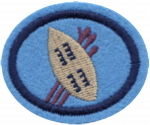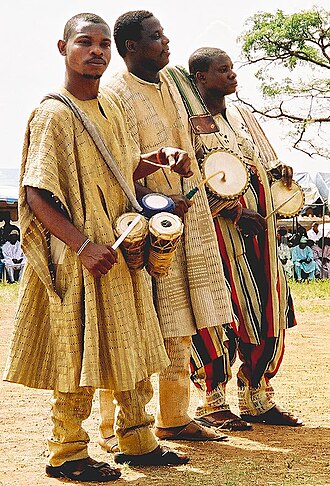Especialidades JA/Tradición africana/Respuestas
| Folclore Africano | ||
|---|---|---|
| Asociación General
|
Destreza: 1 Año de introducción: 2001 |
|
Requisitos
1. Ser capaz de nombrar y localizar al menos 10 diferentes tribus africanas de la actualidad y decir varias características de cada una.
2. Hacer lo siguiente:
a. Seleccionar una tribu africana para el estudio. Si usted pertenece a una tribu africana, seleccionar una que no sea la suya.
b. Encontrar información detallada sobre las tribus seleccionadas, en las siguientes áreas:
i. Los hábitos alimenticios
ii. Ceremonia de iniciación
iii. Médicos tradicionales y yerbateros
iv. Condiciones de vida y cultos
v. Educación��
=vi. Entierros
vii. Dinero
iix. Vestido
ix. Industria
The key figure in the Xhosa oral tradition is the imbongi (plural: iimbongi) or praise singer. Iimbongi traditionally live close to the chief's "great place" (the cultural and political focus of his activity); they accompany the chief on important occasions - the imbongi Zolani Mkiva preceded Nelson Mandela at his Presidential inauguration in 1994. Iimbongis' poetry, called imibongo, praises the actions and adventures of chiefs and ancestors.
|Living conditions = The Xhosa include both the poorest and the richest members of South African society. The poor live in thatched-roof round huts, and in labor camps, while the wealthiest live in modern houses in suburban neighborhoods.
|Religion = The supreme being is called uThixo or uQamata. Ancestors act as intermediaries and play a part in the lives of the living; they are honoured in rituals. Dreams play an important role in divination and contact with ancestors. Traditional religious practice features rituals, initiations, and feasts. Modern rituals typically pertain to matters of illness and psychological well-being.
Christian missionaries established outposts among the Xhosa in the 1820s, and the first Bible translation was in the mid-1850s, partially done by Henry Hare Dugmore. Xhosa did not convert in great numbers until the 1900s, but now many are Christian, particularly within the African Initiated Churches such as the Zion Christian Church. Some denominations combine Christianity with traditional beliefs.
|Education=Education in primary-schools serving Xhosa-speaking communities is in the Xhosa language, but this is replaced by English after the early primary grades. Xhosa is still considered as a studied subject, however, and it is possible to major in Xhosa at the university level.
|Burial=Xhosa homesteads once featured a cattle kraal, and a chief was traditionally buried in the center of this. Other people were buried outside the villages.
|Money=In old times, the Xhosa used cattle as money, but these days they use modern currency.
|Dress=Xhosa today have adopted the modern, Western style of clothing. It has recently become acceptable for women to wear slacks.
|Industry=Prior to the end of Apartheid, most Xhosa men were employed as miners, and women worked on farms or as domestic servants. Those with the education work in the healthcare, education, and in the government.
|Location=The Xhosa are people living in south-east South Africa, and in the last two centuries throughout the southern and central-southern parts of the country.
|Members=7.9 million (2001 estimate) }}
Yoruba
| Yoruba |
|---|
|
The popularly known Vodou religion of Haiti combines the religious beliefs of the many different African ethnic nationalities taken to the island with the structure and liturgy from the Fon-Ewe of present-day Benin and the Congo-Angolan culture area, but Yoruba-derived religious ideology and deities also play an important role. Yoruba deities include "Ọya" (wind/storm), "Ifá" (divination or fate), "Ẹlẹda" (destiny), Orisha or Orisa "Ibeji" (twin), "Ọsanyin" (medicines and healing) and "Ọsun" (goddess of fertility, protector of children and mothers), Sango (God of thunder). Human beings and other sentient creatures are also assumed to have their own individual deity of destiny, called "Ori", who is venerated through a sculpture symbolically decorated with cowrie shells. Traditionally, dead parents and other ancestors are also believed to possess powers of protection over their descendants. This belief is expressed in veneration and sacrifice on the grave or symbol of the ancestor, or as a community in the observance of the Egungun festival where the ancestors are represented as a colorful masquerade of costumed and masked men who represent the ancestral spirits. Dead parents and ancestors are also commonly venerated by pouring libations to the earth and the breaking of kolanuts in their honor at special occasions. Today, many contemporary Yoruba are active Christians (60%) and Muslims (30%), yet retain many of the moral and cultural concepts of their traditional faith.
Ubicación: Nigeria, Benin, and Togo |
Zulu
{{Ethnic group |name = Zulu |image = AAC Worshippers.jpg |image caption = Zulu worshippers at an African Apostolic Church, near Oribi Gorge
|Eating habits = In the precolonial period, indigenous cuisine was characterized by the use of a very wide range of fruits, nuts, bulbs, leaves and other products gathered from wild plants and by the hunting of wild game. The domestication of cattle in the region about two thousand years ago by Khoisan groups enabled the use of milk products and the availability of fresh meat on demand. However, during the colonial period the seizure of communal land in South Africa restricted and discouraged traditional agriculture and wild harvesting, and reduced the extent of land available to black people.
|Initiation ceremony =Boys between the ages of 16-18 were taken to an isolated area and housed in grass huts. During their stay, no one was allowed to see them other than a small group of older women who were there to give them food and watch over them. The boys are given a small item of clothing, which is the only thing they were prior to their circumcision. After the circumcision, they are given a new set of clothing made from leather, and return to their village where they are considered to have entered manhood.
The initiation ceremony for girls began as soon as she began menstruation. She would gather the roots of a certain shrub and use it to make a porridge which she would eat exclusively for seven days. During this time, and for the enxt three months or so, she was confined to her mother's hut. During this time she was to learn to perform several tasks expected of women, including basket weaving and making beaded clothing. She was allowed to have one friend come and stay with her during this time. She was not allowed to be seen by anyone other than her mother and this friend. Her sisters would make her a new outfit from twisted grass, and at the end of the three months, she would put this on, be presented to the village, and she and her friend and sisters would dance and sing, celebrating the end of her initiation. On the following day, the grass outfit would be burned, signifying that the girl had become a woman.
|Shamans = Inyanga (literally "the man of the trees") is a Zulu word for a traditional healer.
Although the word sangoma is generally used in South African English to mean all types of traditional Southern African healers, inyangas and sangomas are in fact different. An inyanga is an herbalist who is concerned with medicines made from plants and animals, while a sangoma relies primarily on divination for healing purposes. The knowledge of the inyanga is passed through the generations from parent to child.
In modern society the status of these medicine men or women has been translated into wealth. Most izinyanga (plural of inyanga) in urban areas have shops with consulting rooms where they sell their medicines.
|Living conditions = The modern Zulu population is fairly evenly distributed in both urban and rural areas. Although KwaZulu-Natal is still their heartland, large numbers have been attracted to the relative economic prosperity of Gauteng province.
|Religion=Most Zulu people state their beliefs to be Christian. Some of the most common churches to which they belong are African Initiated Churches, especially the Zion Christian Church and various Apostolic Churches, although membership of major European Churches, such as the Dutch Reformed, Anglican and Catholic Churches is also common. Nevertheless, many Zulus retain their traditional pre-Christian belief system of ancestor worship in parallel with their Christianity.
3. Contar un cuento popular africano junto con su moraleja.
4. Hacer una colección de al menos 15 objetos fabricados por tribus africanas (que no sean hechos por usted mismo).
Referencias
- Categoría: Tiene imagen de insignia
- Adventist Youth Honors Answer Book/Honors/es
- Adventist Youth Honors Answer Book/es
- Adventist Youth Honors Answer Book/Skill Level 1/es
- Categoría: Libro de respuestas de especialidades JA/Especialidades introducidas en 2001
- Adventist Youth Honors Answer Book/General Conference/es
- Adventist Youth Honors Answer Book/Unknown/es
- Adventist Youth Honors Answer Book/Unknown/Primary/es
- Adventist Youth Honors Answer Book/Stage 100/es
- Adventist Youth Honors Answer Book/Completed Honors


